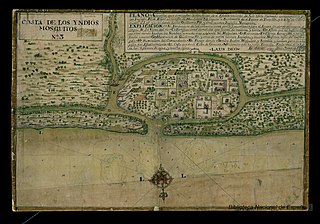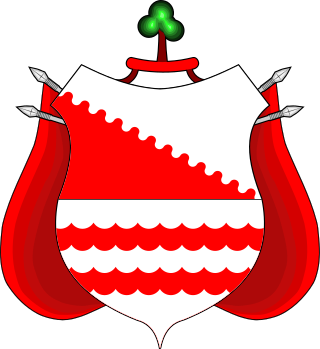
The Mosquito Coast is the area along the eastern coast of present-day Nicaragua and Honduras. It was named after the local Miskito Nation and was long dominated by British interests and known as the Mosquito Kingdom. From 1860 suzerainty of the area was transferred to Nicaragua with the name Mosquito Reserve, and in November 1894 the Mosquito Coast was militarily incorporated into Nicaragua. However, in 1960, the northern part was granted to Honduras by the International Court of Justice.

The Miskitos are a native people in Central America. Their territory extends from Cape Camarón, Honduras, to Río Grande de Matagalpa, Nicaragua, along the Mosquito Coast, in the Western Caribbean Zone. Their population is estimated at 700,000 people as of 2021, according to the official Miskito Database.

Bluefields is the capital of the South Caribbean Autonomous Region in Nicaragua. It was also the capital of the former Kingdom of Mosquitia, and later the Zelaya Department, which was divided into North and South Caribbean Coast Autonomous Regions. It is located on Bluefields Bay at the mouth of the Bluefields River in the municipality of the same name.

The Misumalpan languages are a small family of languages spoken by indigenous peoples on the east coast of Nicaragua and nearby areas. The name "Misumalpan" was devised by John Alden Mason and is composed of syllables from the names of the family's three members Miskito, Sumo languages and Matagalpan. It was first recognized by Walter Lehmann in 1920. While all the languages of the Matagalpan branch are now extinct, the Miskito and Sumu languages are alive and well: Miskito has almost 200,000 speakers and serves as a second language for speakers of other indigenous languages in the Mosquito Coast. According to Hale, most speakers of Sumu also speak Miskito.
Mískito Coast Creole or Nicaraguan Creole English is an English-based creole language spoken in coastal Nicaraguan region of Mosquito Coast on the Caribbean Sea; its approximately 40,000 speakers are spread over the RAAN and RAAS regions of Nicaragua. The region, known before 1986 as the Zelaya department, is today administratively separated into two autonomous regions: North Caribbean Coast (RAAN) and South Caribbean Coast (RAAS). Mosquito is the nickname that is given to the region and earlier residents by early Europeans who visited and settled in the area. The term "Miskito" is now more commonly used to refer to both the people and the language.

Pearl Lagoon is a municipality that is often time called just Lagoon and was historically known as English Bank. It is located in the South Caribbean Coast Autonomous Region of Nicaragua. It is the most important town of the largest coastal lagoon also by the name of Pearl Lagoon in the South Caribbean Coast Autonomous Region of Nicaragua and which the name of the town is derived from. As of 2022, Pearl Lagoon Municipality had a population of 21,360.

The Corn Islands are two islands about 70 kilometres (43 mi) east of the Caribbean coast of Nicaragua, constituting one of 12 municipalities of the South Caribbean Coast Autonomous Region of Nicaragua. The official name of the municipality is Corn Island.

The Treaty of Senock Dawkra, also known as the Treaty Friendship and Alliance, was signed on 16 March 1740, between King Edward I of Mosquitia and the British. Based on the terms of the treaty, King Edward relinquished his kingdom to King George II in return for British military protection. Moreover, the accord dictated that King Edward adopt all English laws throughout his territories.

The Black River settlement was a British settlement on the Mosquito Coast in Central America. It was established in 1732 by a British colonist named William Pitt. The settlement, made on territory claimed but never really controlled by Spain, was evacuated in 1787 pursuant to terms of the Anglo-Spanish Convention of 1786. The Spanish then attempted to colonize the area, but the local Miskitos massacred most of its inhabitants on September 4, 1800. The settlement was abandoned, and its remains can still be seen near the village of Palacios in the Honduran department of Gracias a Diós.
The western Caribbean zone is a region consisting of the Caribbean coasts of Central America and Colombia, from the Yucatán Peninsula in southern Mexico to the Caribbean region in northern Colombia, and the islands west of Jamaica are also included. The zone emerged in the late sixteenth century as the Spanish failed to completely conquer many sections of the coast, and northern European powers supported opposition to Spain, sometimes through alliances with local powers.

The Treaty of Managua, also known as the Zeledon-Wyke treaty, was an 1860 agreement between the United Kingdom and Nicaragua, in which Britain recognised Nicaraguan sovereignty over the Kingdom of Mosquitia, but reserved, on the basis of historical rights, a self-governing enclave known of the Mosquito Reservation for the people, citing earlier treaty arrangements and historical circumstances.

Robert Charles Frederic was the King of the Mosquito Nation, 1824–1842.

George Frederic Augustus I served from 1801 to 1824 as a mostly titular king of the mixed-race Miskito, as the Spanish called them, a Native people of Honduras. Although the title and office were hereditary, the "kings" held no real power, with all political power held by British superintendents in the region instead.

George I was king of the Miskito Kingdom from 1755 to 1776. He was brother of King Edward and son of Jeremy II and was chosen king because Edward's eldest son was still too young to rule.

The battle for Río San Juan de Nicaragua was one of several battles that took place during the Anglo-Spanish War, a subconflict of the Seven Years' War, which lasted from December 1761 until February 1763. The conflict, which took place in July–August 1762, began when William Lyttelton, the British governor and commander-in-chief of Jamaica, sent a naval expedition to Nicaragua with the primary objective of capturing the town of Granada.

Afro-Nicaraguans are Nicaraguans of Sub-Saharan African descent. Five main distinct ethnic groups exist: The Creoles who descend from Anglo-Caribbean countries and many of whom still speak Nicaragua English Creole, the Miskito Sambus descendants of Spanish slaves and indigenous Central Americans who still speak Miskito and/or Miskito Coast Creole, the Garifunas descendants of Zambos expelled from St. Vincent who speak Garifuna, the Rama Cay zambos a subset of the Miskito who speak Rama Cay Creole, and the descendants of those enslaved by the Spanish.

Afro-Hondurans or Black Hondurans are Hondurans of Sub-Saharan African descent. Research by Henry Louis Gates and other sources regards their population to be around 1-2%. They descended from: enslaved Africans by the Spanish, as well as those who were enslaved from the West Indies and identify as Creole peoples, and the Garifuna who descend from exiled zambo Maroons from Saint Vincent. The Creole people were originally from Jamaica and other Caribbean islands, while the Garifuna people were originally from Saint Vincent and the Grenadines. Garifunas arrived in the late seventeen hundreds and the Creole peoples arrived during the eighteen hundreds. About 600,000 Hondurans are of Garífuna descent that are a mix of African and indigenous as of Afro Latin Americans. Honduras has one of the largest African community in Latin America.

Frederick Chatfield was the United Kingdom's consul in Central America from 1834 to 1852, a key period in the decolonisation of the region.
The Nicaragua Crisis of 1894–1895 was triggered by the Nicaraguan annexation of the Mosquito Coast, leading to the temporary British occupation of Corinto.

The House of Miskito, also called the Miskitu or the Miskut, was a noble family from the Miskito coast that came to reign over part of the current territories on the Caribbean coast of Honduras and Nicaragua between 1687 and 1894, under the Kingdom of Mosquitia. Their kingdom became a British protectorate and was one of the last existing ruling monarchies in the Americas.















